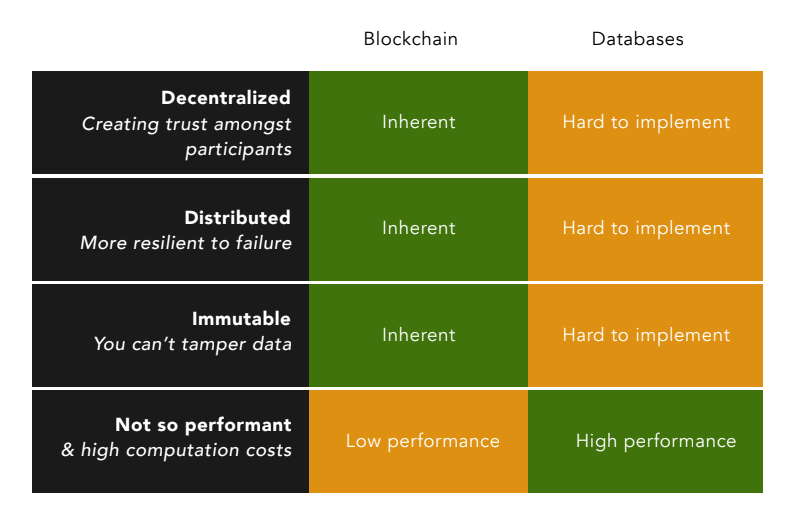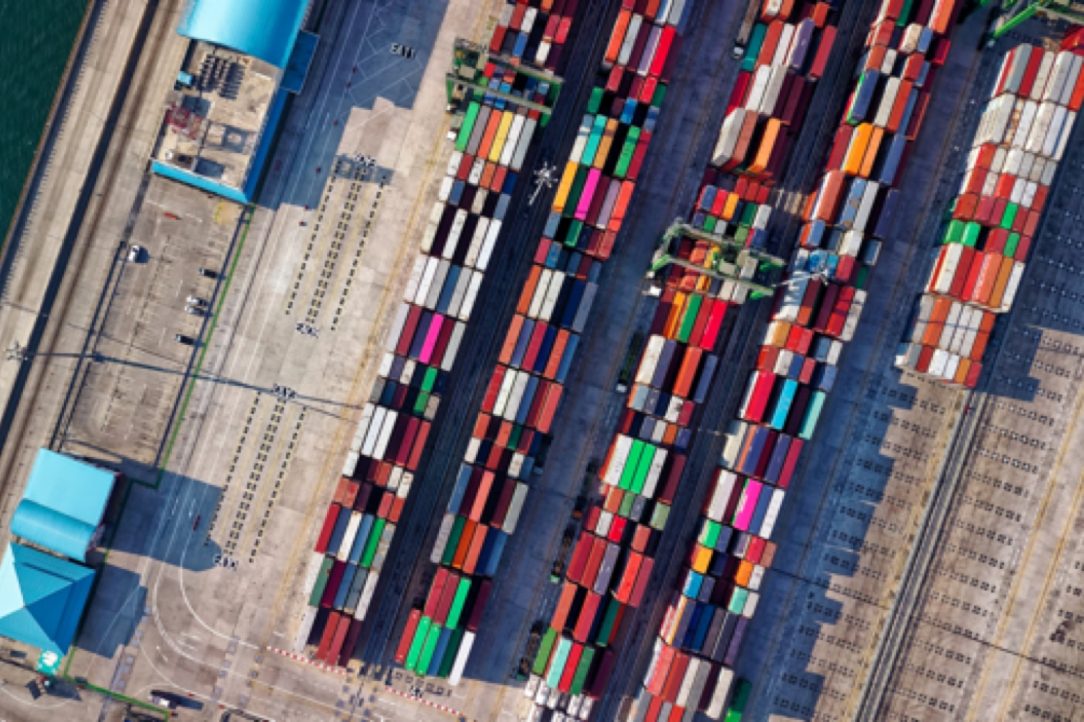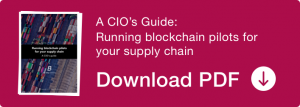Blockchain for supply chain
With the complexity of supply chain management increasing, a lingering problem is the transparency between the end consumers and suppliers. Blockchain solves this problem by making an end to end visibility a reality, improving the quality of communication between trading partners and by automating complex processes. Thus, by being one of the most significant upcoming technologies alongside AI, blockchain is here to stay.
This CIO focused whitepaper explains in detail as to how you can instate a blockchain pilot project. It provides you with an outlook as to how blockchain can solve supply chain problems, how it differs from other technologies and how to implement blockchain for your supply chain.
How is blockchain different from databases?
We have been using traditional databases for a long time now and they have proved their salt. So what exactly can blockchain do for us that traditional databases cannot?
- Decentralized ( Creating trust among participants )
Traditional databases are not decentralized though you can stretch them to be. In cases where more than one organization contributes data and would want to trust the other participating organizations, a decentralized system might be preferred. Decentralization removes the power to create and modify data from a single organization and distributes that power to all the participants. - Distributed ( More resilient to failure )
Databases have proved their strength here. But there is a good amount of engineering effort needed to accomplish resilience. Blockchain is inherently resilient to failure because of the fact that there are multiple nodes that carry the entire copy of the data. A node failing is not going to bring the whole system down. Hence I use the word“inherent.” - Immutable ( You can’t tamper data )
In traditional databases, you can alter data easily. In fact, they are designed to do so. Data once entered in the blockchain can’t be tampered. If you wish to append changes, it has to be done through consensus. There will be an audit trail that shows you what exactly happened. This makes blockchain more secure when it comes to data tampering.
But,
- Not so performant and high computational costs
Almost for every performance metric, you can think of (read, write latency, etc.) centralized database systems win. Blockchain comes nowhere close to the kind of performance traditional centralized database systems offer.

Use Cases: blockchain in supply chain
- Blockchain is effective when it comes to breaking down information silos
A close look at its features will reveal that blockchain is effective when it comes to breaking down information silos. By design, it gives transparency to all the participants as it is a distributed ledger. If desired, there are mechanisms in place to hide sensitive data from other participants as well. - Blockchain can also act as the source of ultimate truth
Blockchain can also act as the ultimate source of truth when there are multiple organizations participating in transactions. Because it is a decentralized system, hence, every transaction registered on the blockchain has to pass the approval criteria set by the majority of the participants. This ensures consensus on every transaction registered on the blockchain. - One version of the truth across the supply chain
Perhaps the most important problem blockchain can solve for the industry is, help all organizations involved in a supply chain maintain “one version of the truth.”
This is a problem the industry has been struggling with for ages. Nonsensically, a shipment can be at two different places at once, inventory counts in your ERP and your 3PL’s ERP can be different. These are problems that frequently occur with existing systems resulting in massive financial losses. Having a distributed, decentralized system that can come to a consensus on transactions is a very effective way of solving this problem. - Tracing assets
When all participants in a supply chain share data on a common blockchain as a consortium, it breaks down information silos. This enables organizations to trace and track assets instantly. Typically information is exchanged between two parties in a supply chain and hence tracing an asset back to its source might take days or weeks. Food traceability and recall, proving the authenticity of products, verifying if materials used in products are ethically sourced and drug trafficking are some important problems that could be effectively fought using blockchain. - End-to-end visibility
Technically, it has been possible to implement an end-to-end visibility system without blockchain. There are even standards defined by organizations such as GS1 to enable interoperability. But lack of end-to-end visibility is a problem that still persists across most supply chains. And understandably so.
Let’s think of end-to-end visibility being implemented using a centralized system (without blockchain). The following questions would arise and remain unanswered without blockchain:
1. Why should one organization (owner of the centralized system) own all the data when there are multiple organizations contributing their slice to form the whole picture?
2. Why should one company reap the benefits of gaining insights from this whole picture?
3. How can other companies be sure that the power centre (owner of the centralized system) is not modifying data to suit their needs?
Blockchain is ethically the right choice here if multiple organizations are contributing data to form the whole picture. With end to end visibility in place, it empowers us with the following:
- Proactive error monitoring
With end-to-end visibility, you are breaking down information silos. This empowers you to catch issues early in your supply chain, keeping the “bullwhip” effect in check. - Insights
Insight into unoptimized processes, the trading partner that is not living up to its SLA and so on. With insights, you can embark on improving your processes to cut costs and improve productivity.
How to implement blockchain in supply chain
It makes sense to pick a pilot that has the following characteristics:
- Non-invasive
The pilot project should not interfere with current processes and systems, interrupting production. - Complementary
The pilot project should aim to fill the gaps you have with your existing systems or should be a solution that enhances the end user experience.
Note: You can iterate on the project phase by phase. For instance, if you want to have an end to end visibility on your supply chain, you can start by connecting data from your ERP and other systems, then move towards connecting data from your EDIs as well. Because most blockchain solutions would need participation from your partners, it is easier to convince them with positive results of your pilot. So pilots can not only solve your problems but can also help you convince your partners to participate and share data.
Main components of a blockchain pilot
- Blockchain Network
A blockchain network with desirable attributes. ( permissioned, on-cloud, etc. ) - Data Extraction
Data extraction from your data sources (ERP databases, EDI files, etc. ) - Data Standards
Data standard (ANSI X12, GS1, etc) using which you can send the data to the blockchain. This is necessary for interoperability. - User Interface App
A simple interface/app that can query the blockchain to display information to the end user.
Note: Certain projects might involve more components depending on the complexity. IoT devices for example. But the above listed are the main components of most use cases you might come across.
Here is an explanation of each component in detail:
- Blockchain Network
Major cloud service providers such as AWS, Azure and Google Cloud are offering blockchain infrastructure. You can deploy Codra, HyperLedger or Ethereum and have a consortium going with just a few clicks. Deploying a blockchain network with the provisions given by these cloud platforms is an easier option as opposed to setting things up yourself on-premise. Ethereum is a permissionless blockchain, while Hyper ledger and Corda are permissioned. This rules out Ethereum. So which blockchain for the supply chain?
Between Corda and Hyperledger, Hyperledger would be a safe bet for the supply chain industry for the following reasons:
1. Corda focuses heavily on the financial industry, hence its features might be more tuned to solving use cases under the financial industry.
2. Hyperledger has already gained adoption by major players in the supply chain industry. Walmart uses Hyperledger to implement Food Traceability. - Data Extraction
This might be a familiar challenge for people who have done integration projects before. You would be mapping the data from your ERP to the data standard you choose to use. In a typical EDI integration project, you would be extracting data out of our ERP and convert them to ANSI X12 or EDIFACT or any other EDI standard mandated by your trading partner. The same challenge exists even here, except you won’t be sending the data as a file over AS2/FTP, rather you would be submitting this standardized data to your blockchain. If you have existing ETL tools such as Informatica or have the ability to code your mappings, you can do so and convert them to the standard you will be using for publishing data on the blockchain.
- Data Standards
All the data on the blockchain would amount to nothing if different systems and trading partners can’t interoperate. Standardizing the data structure is perhaps the most important decision you will have to make. You will have to consider your trading partners, existing systems used across the entire supply chain and also ensure the standardization can handle all the use cases. Sounds like a tough job? That’s probably why you are better off considering existing standards that have evolved over the years. Organizations such as GS1 have standards defined for end-to-end visibility and business transactions. As the blockchain ecosystem evolves, standards will play a key role. It makes sense to invest and go through the learning curve. - User Interface App
This would be your user interface using which end users can view the data in a manner they can understand. You can build a custom web or mobile application that makes use of blockchain SDKs to query data from the blockchain and display it in the user interface. You can optimize the performance of the application by using a database to which you downstream for caching data from the blockchain and have your application fetch data from the database. You don’t have to fetch the data from the blockchain every time the user loads the user interface to view the data. Since centralized databases are far more performant and consume less processing power, this will help you optimize the user experience and reduce computational costs.
Why do you need to run a blockchain pilot?
A pilot project lets you accurately test new technologies before choosing to invest in full-time solutions, helps you validate your metrics along with numerous other benefits. Running a blockchain pilot can thus give you an overall idea as to how blockchain will fit in with your use cases, scale existing technologies, and your team. Blockchain pilot is not an overnight process but a gradual one. However, it is not as rigorous as people think it would be. The key lies in understanding how blockchain differs from existing technologies and the nature of the problems it is good at solving for your supply chain.
Download our comprehensive and shareable pdf on blockchain for supply chain here.
Feel free to reach out to us at hello@byteally.com if you have any questions regarding the blockchain technology.
Related Reads

